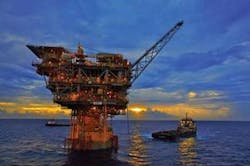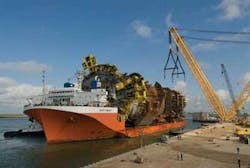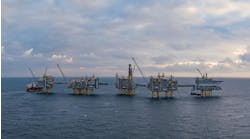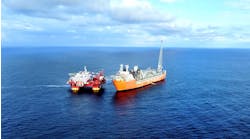David Paganie • Houston
Ursa/Princess life extension under way
Shell is injecting water into the Ursa and Princess reservoirs. This is expected to extend the life of the fields by 10 years, says Shell. The process, known as waterflood, is planned to continue for the next 30 years.
Waterflood is a method of secondary recovery in which water is injected into the reservoir formation to displace additional oil. The water from injection wells re-pressurizes the formation and physically sweeps the displaced oil to adjacent production wells. The Ursa/Princess waterflood topside system injects filtered and treated seawater via flowline to three subsea sites - one to an existing well northwest of theUrsa TLP, one to an existing well southeast of the platform, and one to a new well northeast of the facility. Producing wells will include three from Princess and up to six from Ursa. Both in the Mississippi Canyon area, Ursa is in 3,800 ft (1,158 m) of water and Princess is in 3,650 ft (1,113 m) of water.
Shell operates the Ursa/Princess waterflood project with a 45.39% working interest. Partners are BP with 22.69%, and Exxon Mobil and ConocoPhillips each with 15.96%.
In other Mississippi Canyon area news, Noble Energy has identified a “high-quality” reservoir in the Tortuga prospect within MC 561 and 605. The well, drilled to 19,885 ft (6,061 m) TD, encountered natural gas in a secondary objective, according to Noble. The primary objective was determined to be wet. The well has been temporarily abandoned pending future development plans.
Production begins at Neptune
BHP Billiton has first production from the Neptune field in Green Canyon block 613. Drilled by Transocean in 1995, Neptune was the first discovery in the Western Atwater Foldbelt.
TheNeptune platform, moored in 4,250 ft (1,300 m) of water, is a single-column TLP designed to handle 50,000 b/d of oil and 50 MMcf/d of natural gas.
Operator BHP Billiton reported first production from the Neptune field on July 6. The field is anchored by a TLP production facility in 4,250 ft (1,300 m) of water.
The facility’s structural components inside the hull’s pontoons recently were strengthened after anomalies were identified by the engineering contractor during a routine inspection.
The 5,900-ton (5,352-metric ton) hull was designed by SBM-Atlantia, and fabricated by Signal International in Orange, Texas. The platform’s 5,500-ton (4,990-metric ton) topside processing module, built by Gulf Island Fabrication in Houma, Louisiana, was integrated with the hull by Heerema’s heavy-lift vessel,Thialf. The vessel also installed the hull’s six foundation piles.
The Neptune field development includes six initial subsea wells tied back to the TLP production platform. Processed oil moves to market via the Caesar pipeline, while natural gas is exported via the Cleopatra pipeline. Further development wells are expected to be drilled after interpretation of new seismic data, which will be obtained in the latter half of 2008, according to BHP.
The Neptune field comprises Atwater Valley blocks 573, 574, 575, 617, and 618, where water depths range from 4,200-6,500 ft (1,275-2,000 m).
BHP Billiton operates Neptune with a 35% working interest. Partners are Marathon Oil Co. (30%), Woodside Energy (USA) Inc. (20%), and Maxus (US) Exploration Co. (15%).
MMS report identifies subsea processing hazards
With the advent of subsea processing technology in deepwater, a new report by the MMS identifies available technologies and associated potential environmental hazards.
The report addresses four types of subsea processing technologies including multi-phase pumps, separation, separators with scrubbers and pumps, and multi-stage separation and fluid treatment.
The report finds the major potential environmental hazards associated with subsea E&P operations will be similar to those associated with existing offshore oil and gas production. These include the release of drilling fluids and untreated drill cuttings during E&P, release of large volumes of hydrocarbons or utility fluids due to failures in piping, seals, and connections, and the release of untreated produced water and sands.
One of the primary differences is the ability to detect and respond to releases at or near the seabed, according to the report. The most likely potential environmental hazard is leakage of fluids at various connections or through ruptures in the piping and subsea processing equipment, the report says. The report recommends the characterization of the eco-toxicity of any new chemicals used in subsea production activities. And to minimize the potential release of untreated produced water and sands, subsea processing systems should be developed to remove water and sand from the production stream and re-inject them into subsurface formations, the report concludes. Also, new methods and procedures, effective in deepwater, are needed to detect and respond to leakage.
Perdido lands in Texas
The Shell-operatedPerdido truss spar has arrived in Ingleside, Texas, onboard Dockwise’s semisubmersible, Mighty Servant 1. The 20,956-ton (19,011-metric ton) hull, built by Technip in Pori, Finland, was delivered on June 27.
ThePerdido hull sailed from Pori, Finland, on May 27 and arrived in Ingleside, Texas, on June 19. There the hull is being outfitted for offshore installation before transit to the Alaminos Canyon area where it will be moored on the Great White field in 8,000 ft (2,438 m) of water.
Kiewit Offshore Services in Ingleside is fabricating the topsides designed to handle 130,000 boe/d (100,000 b/d of oil and 200 MMcf/d of natural gas). Slated for August, the hull will be towed to Alaminos Canyon block 857 where it will be upended by Heerema and attached to nine mooring lines connected to the seafloor. Heerema also is contracted to mate the topside with the hull, which is scheduled for early 2009. First production from the drilling, production, and quarters facility is expected by the end of the year.
Shell is 35% owner/operator of thePerdido spar. Partners are Chevron (37.5%) and BP (27.5%).
Meanwhile, Oceaneering International has secured a contract from Shell to fabricate and install subsea hardware on the project. The hardware includes 29 flowline and well jumper spools, a pipeline tie-in sled, and related products. Installations are scheduled to begin later this year.
Oceaneering plans to install the subsea components with its DP-capable vessels, including theOlympic Intervention IV. The vessel, equipped with a 150-ton (136-metric ton) heave compensated crane, was scheduled to join the active fleet in the third quarter.
ATP to develop Clipper
ATP Oil & Gas Corp. has acquired a 55% working interest in Green Canyon blocks 299 and 300, collectively known as “Clipper,” with wells in 3,400 ft (1,036 m) of water.
The company plans to complete one existing well, and sidetrack and complete a second well. A tieback to existing infrastructure is anticipated, with first production in 4Q 2009. Four wells drilled in 2005 and 2006 logged hydrocarbons, but none were developed.
“Over the next 18 months, ATP plans to develop Clipper by procuring equipment, completing and tying-back two wells for over 60 Bcfe of reserve potential,” says George R. Morris, COO of ATP.
Transocean scores contract record
Eni has contracted Transocean’sDeepwater Pathfinder for five years at $650,000 per day – the highest floater day rate ever. The contract begins in March 2010 following completion of the rig’s existing contract commitments. Eni will use the rig primarily in the Gulf of Mexico.
TheDeepwater Pathfinder is a single-activity rig capable of drilling in water depths up to 10,000 ft (3,048 m).
Eni also booked Transocean’s semisubmersible,Transocean Marianas, for a two-year contract in the GoM scheduled to begin in December 2009. The estimated day rate is $565,000, up from its current contract rate of $446,000.
Meanwhile, Transocean reports a healthy renewal for its semisubmersible,GSF Development Driller II, with BP for an estimated $580,000 per day, up from its current contract day rate of $208,000. The five-year contract is scheduled to begin in November.





